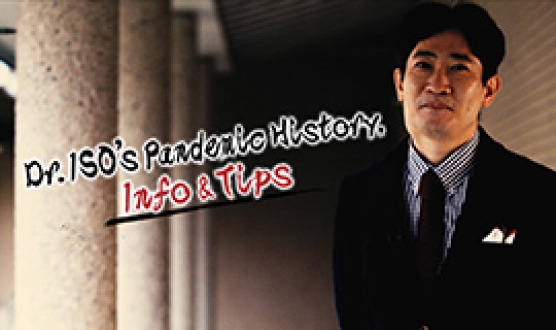Dr. ISO's Pandemic History, Info & Tips
How can we associate better with COVID-19? Let's find the key by learning about the history of the infectious diseases Japan has experienced.
Presenter: Isoda Michifumi, Historian
私たちは COVID-19とどうやって上手く付き合っていけるのでしょうか?日本人がかつて経験した感染症の歴史の中からヒントを見つけていきましょう。
【出演】磯田道史(歴史学者)
Expelling Epidemics with Yokai 〜疫病退散とキャラクター〜
1月7日(木)0:40 - 0:45 / 6:40 - 6:45 / 12:40 - 12:45 / 18:40 - 18:45
Drawing Yokai, supernatural creatures like goblins, together to get rid of
an epidemic was a typical way to provide relief in the Edo period (1603-1868). Dr. ISO shows examples such as Amabie.
江戸時代(1603-1868)、疫病退散のために妖怪の絵をみんなで描く行為は、不安を取り除くための代表的な方法でした。磯田博士がアマビエなどの例を紹介します。
Epidemics in the Nara Period 〜奈良時代のパンデミック〜
1月14日(木)0:40 - 0:45 / 6:40 - 6:45 / 12:40 - 12:45 / 18:40 - 18:45
A popular Japanese tourist spot, the Great Buddha at Todaiji Temple, is said to be constructed because of a major
outbreak of smallpox. Dr. ISO explains why it occurred in the Nara Period (710-794).
日本で人気の観光スポット・東大寺の大仏は、天然痘の大流行により造られたとも言われます。奈良時代(710-794)にどうしてそのようなことが起こったのか、磯田博士が解き明かします。
Social Distancing in the Heian Period 〜平安時代のソーシャルディスタンス〜
2月4日(木)0:40 - 0:45 / 6:40 - 6:45 / 12:40 - 12:45 / 18:40 - 18:45
Girls brought up protectively in good families in the Heian period (794-late 12th) basically stayed socially distanced. Dr. ISO talks about the "zoning concept" of Japanese people.
Naming of Diseases in the Edo Period 〜江戸時代の病気の名付け方〜
3月4日(木)0:40 - 0:45 / 6:40 - 6:45 / 12:40 - 12:45 / 18:40 - 18:45
During the Edo period (1603-1868), many infections were named after something popular at that time, for instance songs or a sumo wrestler. Dr. ISO introduces distinctive cases.
江戸時代の疫病には、当時の世の中で流行っていたもの、例えば小唄や人気力士にちなんで名付けられた例がたくさんあります。磯田博士が面白い例を紹介します。
The Gion Festival for the God of Plague 〜祇園祭は流行り病の神へのおもてなし〜
3月11日(木)0:40 - 0:45 / 6:40 - 6:45 / 12:40 - 12:45 / 18:40 - 18:45
The Gion Festival in Kyoto, which goes back to the 9th century, is a festival to provide hospitality to the God of Plague. Dr. ISO explains how Japanese have traditionally associated with epidemics.
9世紀から続く京都の祇園祭は、疫神をもてなすための祭りとされています。日本人はどうやって疫病と付き合ってきたか、磯田博士が解説します。
Business Self-restraint in the Edo Period 〜江戸時代の営業自粛〜
3月21日(日)20:25 - 20:30
There was business self-restraint in the Edo period as well, especially with restaurants, inns and teahouses. Dr. ISO also refers to the episode of self-restraint when the shogun became ill.
江戸時代にも、疫病流行時には旅籠や茶屋などが営業自粛をしました。更に、将軍が病気になった時にも人々は自粛をしたのです。磯田博士がそうした例を解説します。
Notices Instead of Vaccine 〜ワクチン代わりの張り紙〜
3月22日(月)00:45 - 00:50
What did people do in pre-modern times before vaccines were developed? In Japan, notices were displayed. Dr. ISO shows unique examples such as "Jo-zake ari," meaning "We have high-quality sake."
ワクチンが開発される前の時代、人々はどうやって疫病を退治したのでしょう? 日本では「張り紙」が使われました。「上酒あり」などの面白い例を磯田博士が紹介します。
Benefits in the Edo Period 〜江戸時代の給付金〜
3月22日(月)06:45 - 06:50
Benefits existed in the Edo period, too. For example, 7.5 kilos of rice was given to each backstreet tenement house, and importance was placed on speed. Dr. ISO explains why they could have done so.
江戸時代にも給付金はありました。例えば裏長屋には米五升、重視されたのはスピード感でした。なぜそのような対処ができたのか、磯田博士が説明します。
※この番組は放送終了後、HP(外部サイトにリンクします)にてオンデマンド視聴(無料)が可能です。
